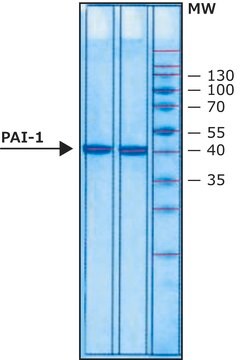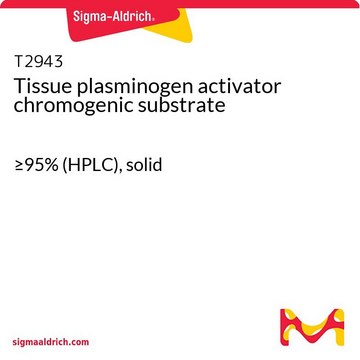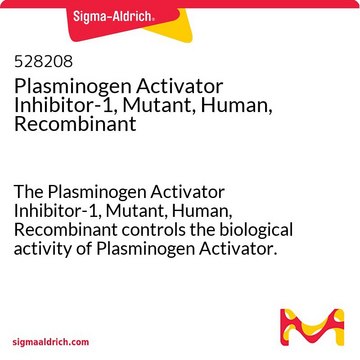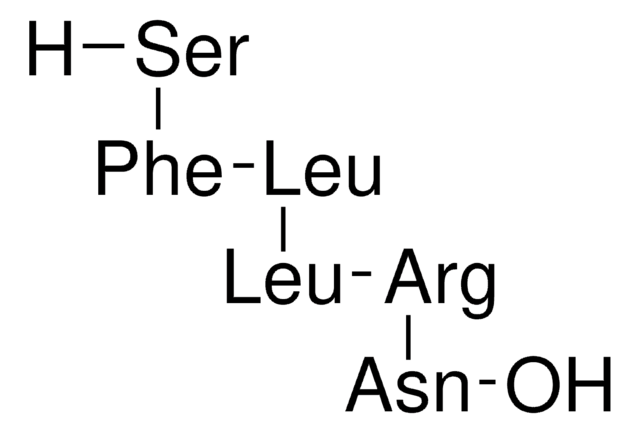528205
Plasminogen Activator Inhibitor-1, Human, Recombinant
The Plasminogen Activator Inhibitor-1, Human, Recombinant controls the biological activity of Plasminogen Activator. This small molecule/inhibitor is primarily used for Protease Inhibitors applications.
Sinonimo/i:
PAI-1
Autenticatiper visualizzare i prezzi riservati alla tua organizzazione & contrattuali
About This Item
Codice UNSPSC:
12352200
NACRES:
NA.77
Prodotti consigliati
Livello qualitativo
Saggio
≥98% (SDS-PAGE)
Forma fisica
liquid
Produttore/marchio commerciale
Calbiochem®
Condizioni di stoccaggio
OK to freeze
avoid repeated freeze/thaw cycles
Condizioni di spedizione
wet ice
Temperatura di conservazione
−70°C
Descrizione generale
PAI-1 is the primary inhibitor of both tissue plasminogen activator (tPA) and urokinase (uPA). PAI-1 can exist either in an active inhibitory conformation or in an inactive or latent conformation. This highly purified preparation has not been exposed to denaturing conditions and has been chromatographically purified of latent material. PAI-1 is a marker for acute myocardial infarction and several thrombolytic disorders. Protects platelets against the inhibitory effects of plasma. Reported to be an important prognostic factor in breast cancer patients. PAI-1 is highly stable when stored at or below pH 6.6.
Primary inhibitor of both tissue plasminogen activator (tPA) and urokinase (uPA). PAI-1 is synthesized by vascular epithelium and hepatocytes. Used as a marker for acute myocardial infarction and in the diagnosis of several thrombolytic disorders. Protects platelets against the inhibitory effects of plasma. Shown to have a role complimentary to that of α2-anti-plasmin. Elevated levels are found in subjects with accelerated coronary artery disease. PP1 activity may limit the extent of metastasis, since uPA activity is a major contributory factor promoting dissolution of tumor matrix and basement membrane. May serve as an independent and strong prognosticator in breast cancer patients. Patients having elevated levels of PAI-1 in their primary tumors are more prone to relapse. Can exist either in an active inhibitory conformation or in an inactive or latent conformation. This highly purified preparation has not been exposed to denaturing conditions and has been chromatographically purified free of the inactive material.
Azioni biochim/fisiol
Cell permeable: no
Primary Target
Tissue plasminogen activator (tPA) and urokinase (uPA)
Tissue plasminogen activator (tPA) and urokinase (uPA)
Product does not compete with ATP.
Reversible: no
Attenzione
Toxicity: Standard Handling (A)
Stato fisico
In 150 mM NaCl, 50 mM sodium phosphate buffer, 1 mM EDTA, pH 6.6.
Ricostituzione
Following initial thaw, aliquot and freeze (-70°C).
Altre note
Vaughan, D.E., et al. 1995. J. Clin. Invest. 95, 995.
Dimitri, G., et al. 1993. Boll. Chim. Farmaceutico 132, 272.
Janicke, F., et al. 1993. Breast Cancer Res. Treatment 24, 195.
Klasser, K.J., et al. 1993. Coron. Artery Dis. 4, 713.
Robbie, L.A., et al. 1993. Thromb. Hemost.70, 307.
Lawrence, D., et al. 1989. Eur. J. Biochem.186, 523.
Collen, D. and Lijnen, H.R. 1987. In The Molecular Basis of Blood Diseases (Stamatoyannopoulus, G., et al. Eds.) W.B. Saunders
Ginsberg, D., et al. 1986. J. Clin. Invest.78, 1673.
Vassalli, J.D., et al. 1985. J. Cell Biol.100, 86.
Dimitri, G., et al. 1993. Boll. Chim. Farmaceutico 132, 272.
Janicke, F., et al. 1993. Breast Cancer Res. Treatment 24, 195.
Klasser, K.J., et al. 1993. Coron. Artery Dis. 4, 713.
Robbie, L.A., et al. 1993. Thromb. Hemost.70, 307.
Lawrence, D., et al. 1989. Eur. J. Biochem.186, 523.
Collen, D. and Lijnen, H.R. 1987. In The Molecular Basis of Blood Diseases (Stamatoyannopoulus, G., et al. Eds.) W.B. Saunders
Ginsberg, D., et al. 1986. J. Clin. Invest.78, 1673.
Vassalli, J.D., et al. 1985. J. Cell Biol.100, 86.
Note legali
CALBIOCHEM is a registered trademark of Merck KGaA, Darmstadt, Germany
Codice della classe di stoccaggio
10 - Combustible liquids
Classe di pericolosità dell'acqua (WGK)
WGK 1
Punto d’infiammabilità (°F)
Not applicable
Punto d’infiammabilità (°C)
Not applicable
Certificati d'analisi (COA)
Cerca il Certificati d'analisi (COA) digitando il numero di lotto/batch corrispondente. I numeri di lotto o di batch sono stampati sull'etichetta dei prodotti dopo la parola ‘Lotto’ o ‘Batch’.
Possiedi già questo prodotto?
I documenti relativi ai prodotti acquistati recentemente sono disponibili nell’Archivio dei documenti.
Il team dei nostri ricercatori vanta grande esperienza in tutte le aree della ricerca quali Life Science, scienza dei materiali, sintesi chimica, cromatografia, discipline analitiche, ecc..
Contatta l'Assistenza Tecnica.








